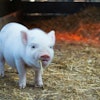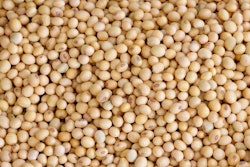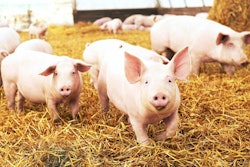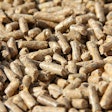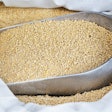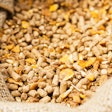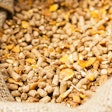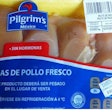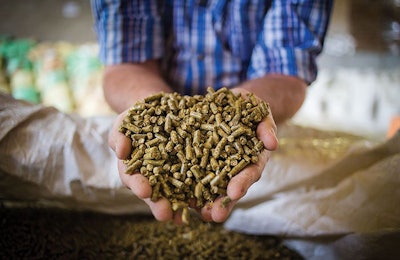
New sensor technology analyzes particle size distribution during manufacturing and allows operators to take immediate action when deviations occur.
Particle size is one of the main characteristics of feed that has significant influence on animal performance and health. For pig feed, the right balance between fine particles for maximum performance and coarse particles to maintain animal health must be found. In broiler nutrition, coarse granulation adapted to the age of the birds is essential for the development of the digestive tract.
Grinding is the key step in determining the granulation of feed. Numerous factors can cause deviations in the required particle size. Immediate detection of variations is essential in ensuring high feed quality, but difficult to realize using traditional methods for particle size analysis. New sensor techniques can support feed manufacturers in analyzing particle size distribution quickly enough to enable immediate action to be taken when deviations occur.
The challenges of traditional particle size determination
Traditionally, particle size distribution is determined offline in the lab by sieve analysis. A sample is taken after mixing and sieved with a sieve tower in a sieve shaker. Particle size distribution can be determined by weighing the different fractions. Sieving as a manual procedure is time-consuming and, therefore, often only performed sporadically. Furthermore, the results are obtained with a time lag compared to the production process so that it is no longer possible to make any changes to the process. Although sampling, analysis and data recording are described precisely in the guidelines, they are performed manually, therefore constituting common sources of error. Alternative lab methods using automated measurement systems with laser diffraction or dynamic image analysis reduce the probability of error of the analysis itself; however, sampling and sample preparation can still give rise to deviations.
Advantages and requirements of online measurement systems
Online measurement systems can help to overcome the disadvantages described above and enable continuous measurements. They include an automated sampling procedure and preparation, near-time results and automated data recording, and are therefore superior to lab analyses. By continuously monitoring particle size distribution deviations caused by variations in environmental conditions or raw materials or by adaptations in the production process, any wear or damage of the equipment can be detected immediately. This enables the operator to promptly take any necessary corrective actions.
However, in order to ensure reliable results, online measurement systems must fulfill several requirements such as allowing a representative sampling procedure to be performed, enabling sample preparation and ensuring the reproducibility of measurements and short measurement times. A sample is regarded as representative, if it is of a sufficient size to allow a statement for the whole batch (see figure 1) to be made. Furthermore, the point in the process at which the samples are taken and how they are taken determine the composition of the sample. Another important point is sample preparation: separation of oversized foreign particles and the breaking of agglomerates without particle size reduction are key steps in the process.
Figure 1: Importance of the right sample size demonstrated
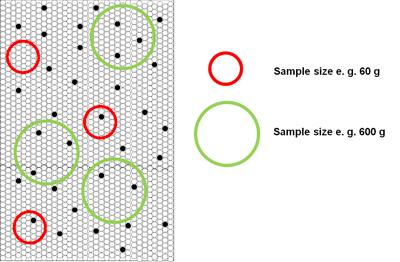 If the sample size is too small, it is probable that deviations will not be detected (red circles). With a sufficient sample size (green circles), the probability of detecting deviations increases. (Buhler Group)
If the sample size is too small, it is probable that deviations will not be detected (red circles). With a sufficient sample size (green circles), the probability of detecting deviations increases. (Buhler Group)For the application, the reproducibility of measurements and the detection of differences are important points for determining informative value. Reproducibility demonstrates the accuracy of the sensor and can be determined by repeated measurements of the same sample.
Figure 2. Cumulative particle size distribution
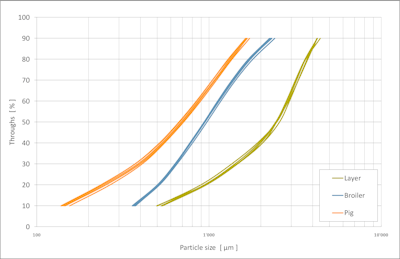 Cumulative particle size distribution determined using a Bühler DYTA online particle size measurement unit. Reproducibility was tested by taking repeated measurements (n=5) of three different kinds of feed mash: layer, broiler and pigs. Values are shown for d10 to d90. (Courtesy Bühler Group)
Cumulative particle size distribution determined using a Bühler DYTA online particle size measurement unit. Reproducibility was tested by taking repeated measurements (n=5) of three different kinds of feed mash: layer, broiler and pigs. Values are shown for d10 to d90. (Courtesy Bühler Group)A further major requirement for a measurement system is its ability to detect deviations. To test this, selected fractions can be added to a sample. Figure 3 shows such an experiment. In trials 1-4, density distributions of the same feed sample were determined. In trial 5, a fraction with 500-710 µm was added, amounting to 10% of the overall sample size. In trial 6, a fraction with 125-250 µm was added with the same proportion as before. The data demonstrates that deviations in granulation can be detected with a high resolution. Particularly in the range between 300 and 500 µm, detection of deviations is limited with sieve analysis, as sieves tend to get blocked, thus demonstrating another advantage of the sensor technique used in the online measurement system.
Figure 3. Particle size distribution trial results
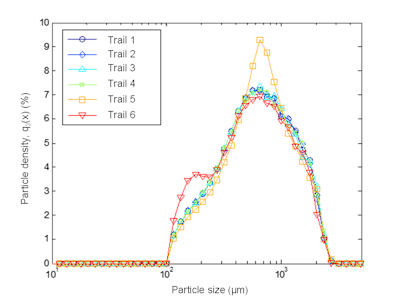 Particle size distribution of four repeated measurements of the same sample (trial 1-4), with the addition of a fraction with 500-710 µm (trial 5) and 125-250 µm (trial 6) amounting to 10% of the overall sample size, respectively. (Courtesy Bühler Group)
Particle size distribution of four repeated measurements of the same sample (trial 1-4), with the addition of a fraction with 500-710 µm (trial 5) and 125-250 µm (trial 6) amounting to 10% of the overall sample size, respectively. (Courtesy Bühler Group)In terms of operating conditions, online sensors in feed mills are exposed to harsh conditions and this represents a challenge — especially for the sensor which is the most sensitive part of the system. Permanent exposure to dust, varying temperatures and moisture are tough on the sensor technology.
Comparability of sieve analysis and online measurement
It is not possible to directly compare particle size distribution analyzed by sieving (in the way it is traditionally performed in feed mills) and the results of an online measurement system. However, during sieve analysis, a tolerance range is defined for each recipe representing acceptable variations around the mean value. These tolerance ranges can be compared with the mean value determined with the online measurement tool, thus giving an initial indication about any deviations between both methods when implementing the new system. Through the continuous analysis of all batches using the online system, enough data can be collected to define the new specification within a short period.
Conclusion
Online particle size measurement is a new tool for process control and optimization. Continuous monitoring can ensure defined and constant granulation, thereby guaranteeing reliable production. Incorrect and suboptimal machine settings, technical disturbances such as sieve breakage or wear of hammers as well as deviations caused by raw material variations can be detected immediately, enabling action to be taken directly. Through the fully automated system, the workload is reduced while the amount and reliability of the data provided increase. However, most people assume that grinding determines the final particle size of feed. During the production of pelleted feed, a further modification of the particle size takes place and this is often overlooked. The effects of pelleting on particle size and their importance will be explained in the next article in this series.
Editor’s note: This is the fourth installment of a five-part series, “All about particle size: the influence of feed particle size on animal performance,” contributed by the Bühler Group. It aims to explain the importance of particle size in pig and broiler feed and explore the possibilities for modifying and controlling particle size during feed processing.
